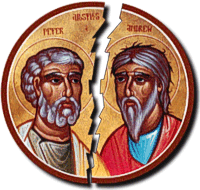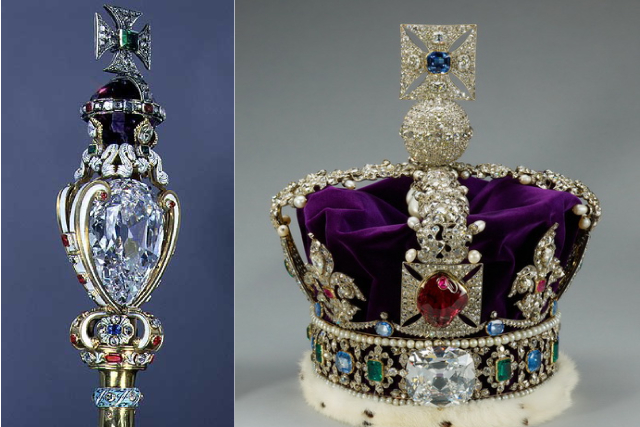The Great Schism

When we are talking about the Great Schism, we can refer either to the split between the Byzantine Church and the Roman Church that occurred in 1054 or to the Great Western Schism that occurred between 1378 and 1417.
Both events played a major role in the history of Christianity.
When was the Great Schism
Going though the history of the schisms, this article focuses on understanding the great schism definition, why did the great schism happened and what were the effects of the great schism.
The great schism of 1054 or Great Eastern Schism
The Great Eastern Schism is the name given to the separation of the Roman and Byzantine branches of the Christian church.
This separation of the Latin and Greek churches is sometimes dated from 1054, the date when Byzantine and Roman officials excommunicated each other. Actually, the break came about through a gradual process of estrangement that extended from the 9th to the 15th century.
What are three causes of the great schism in Christianity?
Causes of the schism included political, cultural, economic, and social as well as theological differences that originated before 1000. The political unity of the Mediterranean world was shaken and finally destroyed through the barbarian invasions in the West and the rise of Islam in the East.
Communication between the Greek-speaking East and the Latin West broke down as church and other leaders in each no longer spoke or read the language of the other half of the Christian world.
Charlemagne and Adrian IIn 800 Charlemagne was crowned by the Pope as the new emperor of the Roman Empire, but he was not recognized by the Byzantine Greeks.
The court theologians of Charlemagne considered the Eastern Christians to be heretics because the latter refused to admit the word Filioque into the Creed, while the Greeks viewed the introduction of that doctrine into the Nicene-Constantinople Creed as unforgivable.
The development of church order in the West made the pope of Rome the strong monarchical bond of unity throughout the Western world.
The East had no comparable structure; the church was administered by a hierarchy whose members were considered equals.
Photius IEast-West issues crystallized in a quarrel between Photius, patriarch of Constantinople, and Pope Nicholas I, which resulted in the Photian schism (867).
Photius was eventually recognized by the pope as the legitimate successor of Patriarch Ignatius after the latter’s death in 877.
However, Photius had condemned the primacy of the pope of Rome and the use of the Filioque as unacceptable to the Christian East.
In the 11th century other factors aggravated these differences. In 1009 the Filioque clause was made an essential part of the Latin profession of faith. In retaliation the name of the pope of Rome was dropped from the diptychs, or lists of those patriarchs with whom a patriarchal church was in communion.
Under strong reforming popes such as Gregory VII, the papacy claimed jurisdiction over all Christian churches. This claim was ignored in the East.
The Normans conquered the southern part of Italy, which was under Byzantine control, and insisted on enforcing Latin customs.
Patriarch Michael Cerularius retaliated in 1052 by closing the Latin churches in Constantinople.
In 1054, Pope Leo IX sent three legates, led by Cardinal Humbert, to Cerularius.
On July 16, 1054, Humbert laid upon the altar of Hagia Sophia a bull of excommunication of Cerularius and his partisans.
Michael Cerularius summoned his 20 metropolitans and anathematized “the impious document and its authors.” This seemed to be more a personal quarrel than an excommunication, and friendly relations still continued between the churches.
Effect of the great schism
The Latin Crusaders made the schism definitive. During the First Crusade (1098–1099) the Latins captured Antioch and Jerusalem and set up Latin patriarchates, which caused friction with the Oriental patriarchates. In 1204, during the Fourth Crusade, the Latins sacked Constantinople. Their swords finally cut Christendom into two distinct Roman and Orthodox parts.
Attempts at Reconciliation
Two attempts at reunion took place, one in 1274 at the Second Council of Lyons and the other in 1438–1439 at the Council of Florence. At both councils the Orthodox accepted the Latin papal claims and the doctrine of the Filioque, but the unions effected were mainly on paper. The masses of Christians, the monks, and the lower clergy were not ready for the healing of the schism.
On April 7, 1453, the Turks took Constantinople and the Byzantine Empire came to an end. The separation of East and West was accepted as a reality by both Orthodox and Catholics.
The great schism of 1378 or Great Western Schism
Great Western Schism is the name given to the period from 1378 to 1417, when there were two or at times three rival claimants to the papacy. The schism split the whole Western Christian world into opposing camps.
What caused the Great Schism
The schism began at the end of the so-called Babylonian Captivity. From 1309 to 1377 the papacy was dominated by the kings of France, and the papal court was located in the French city of Avignon.
In 1377, Pope Gregory XI returned to Rome. However, he found the city in a state of turbulence, and he was planning to go back to Avignon when he died on March 27, 1378. When 16 cardinals convened on April 7 to elect a new pope, the Roman populace loudly demanded the election of a Roman or at least an Italian.
On the next day the cardinals elected Bartolommeo Prignano, archbishop of Bari, a man known to them for his learning and piety.
Before they could notify him, the mob, not knowing that an Italian had been chosen, broke into the Vatican palace, and the cardinals fled.
Reassembling on April 9, they informed Prignano of his election, and he took the name Urban VI (reigned 1378–1389). There is now no question about the validity of his election and therefore of the legitimacy of his successors.
For five months after the election the cardinals acknowledged Urban VI, but they gradually began to have misgivings. Displaying a lack of tact and moderation, Urban declared his intention of reforming the church and condemned the cardinals for their luxury and idleness.
They therefore turned against him and on one pretext or another abandoned Rome. At Anagni on August 2 the dissidents published a manifesto in which they pronounced his election null and void, on the ground that pressure from the Romans had made a free election impossible.
Denouncing Urban as a usurper, they elected a rival pontiff, Cardinal Robert of Geneva, on September 20, and he took the name Clement VII.
Thus the church was divided in its allegiance to these two men, who promptly excommunicated one another.
Unable to drive Urban from Rome, Clement established himself at Avignon in June 1379.
Western European rulers were forced to declare themselves for the Roman or the Avignon pope. France was the staunchest supporter of Avignon and was followed by Castile, Aragon, Scotland, and Savoy.
England, Portugal, Hungary, the Scandinavian states, and the Holy Roman Empire supported Rome. Devout people in these realms usually followed their king’s lead. Thus, for example, St. Vincent Ferrer and St. Colette favored Avignon, while St. Catherine of Siena and St. Catherine of Sweden favored Rome.
Growth of the Schism
When Urban VI died in 1389 the Roman cardinals insisted on electing a successor, Boniface IX (reigned 1389–1404), rather than recognizing Clement VII to terminate the schism.
Similarly, when Clement died, the Avignon cardinals elected Benedict XIII. As a solution, the University of Paris proposed the resignation of the two pontiffs, arbitration by judges selected by them, or the summoning of a general council.
When Boniface IX died, the Roman cardinals elected Innocent VII (reigned 1404–1406) and after his brief reign, Gregory XII (reigned 1406–1415), both of whom pledged to work for reunion. In 1407 the Roman and Avignon popes agreed to resign simultaneously. However, neither man trusted the other, and they did not carry out the pact.
Origin of the Pisan Line
When Gregory XII created four new cardinals, including two of his nephews, contrary to a promise made at his election, his other cardinals withdrew their obedience.
The cardinals at Avignon also abandoned Benedict XIII. Thirteen cardinals from both sides agreed to summon a general council to settle the schism. This assembly met at Pisa on March 28, 1409.
The rival pontiffs refused to attend and tried to counteract it by calling councils of their own. About 500 prelates attended the Council of Pisa.
Alexander VThe council declared that it represented the whole church and that the cardinals had had the power to convoke it.
When the two popes refused to answer a summons to appear, the Council deposed them both on June 5, 1409.
The cardinals then elected Alexander V (reigned 1409–1410). Although most of Europe recognized him, his election did not put an end to the schism, because neither the Roman nor the Avignon pope would abdicate.
Thus there were three claimants to the papacy.
Council of Constance
The scandal distressed many souls, and in 1413, Emperor Sigismund (reigned 1410–1437) persuaded the second Pisan claimant, who had taken the name John XXIII, to call a new general council to meet at Constance.
The objectives of the Council were to heal the schism, to reform the church, and to suppress heresy. In addition to the Pisan pope and the Emperor, envoys from many secular rulers and about 600 bishops, theologians, and canon lawyers attended.
The Council opened on Nov. 5, 1414, and decided that voting should be by nations—that is the English, French, Italians, Germans, and Spanish would each have one vote.
Realizing that the Council did not intend to confirm him, John XXIII fled from Constance in March 1415, hoping the assembly would dissolve. Sigismund intervened and persuaded the prelates to remain.
Then on April 6 the Council enacted the decree Sacrosancta, declaring that the Council represented the universal church and that all Christians, including the pope, were subject to it. On May 29, the Council deposed John XXIII; and on July 4, Gregory XII, after convoking the Council, abdicated.
The Avignon pope, Benedict XIII, refused to submit and was deposed on July 26, 1417.
Having a clear field, a conclave of 23 cardinals and six delegates from each of the five nations on November 11, 1417, elected Cardinal Odo Colonna, who took the name Martin V (reigned 1417–1431).
The election of Martin V terminated the schism, though Benedict XIII stubbornly persisted in calling himself Pope until he died in 1423 at Peñiscola in his native Aragon.
His cardinals chose a successor, Clement VIII, who submitted to Martin V six years later.
The schism did untold harm to papal prestige and intensified the growth of hostility to the papacy in many parts of Europe.
The failure of papal leadership encouraged the development of the conciliar theory, which proposed that the general council, representing the whole body of Christians, was the highest governing agency in the church, superior even to the pope. The upheaval occasioned by the schism led directly to the Protestant Reformation.


